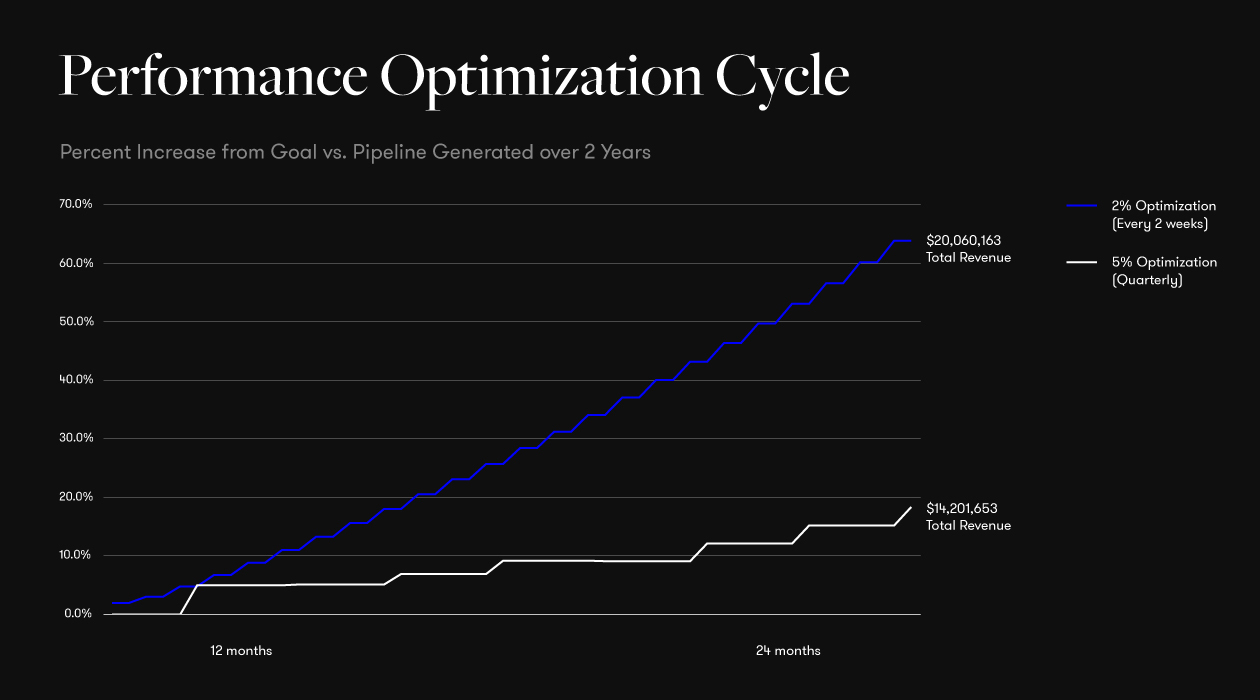
How Poor Outbound Performance Management Will Affect Revenue in 2023
Jake Dunlap
“Quick analogy for you. If Marketing spends $100K a month on ads, they will use 15-20% of that budget to optimize performance. At the same time, we’re spending $100K on SDRs and only spending $4,000 or $5,000 a month on optimizing outbound performance. Why?”
I conducted a few polls throughout 2022 around outbound. 71% was the lowest result of respondents who answered that they weren’t hitting their numbers. In other months, it was in the high 70s or low 80s. That’s about 3 in 4 people reporting that they weren’t hitting outbound targets in 2022.
2023 is going to be a very difficult year for outbound in the way that we’ve known it. For sales in general, we haven’t seen a year like this in a long time.
We’re going to have to get creative, and we’re going to have to deal with changes in the fundamentals of outbound that we should have dealt with years ago.
So that’s what this session is all about. Starting with what used to work in outbound and why, I’ll talk about what’s transformed the outbound process today and the lack of outbound performance management that we have to incorporate into our strategy, or we will continue to hover around 70+% missed targets in 2023.
-
- Outbound & Activity Metrics Today
- What is Outbound Performance Management?
- Outbound Performance Management Dream Team
Recap: How Poor Outbound Performance Management Will Affect Revenue in 2023
The important bits
-
- 2:15 – Last year, I did several polls around this, and the lowest result we ever got was 71% of people saying their team missed their outbound number.
- 3:45 – This is not going to be the easiest year. We’re going to have to get creative, and we’re going to have to deal with things in outbound that we should have dealt with years ago.
- 5:59 – We haven’t adapted our tracking in response to the introduction of LinkedIn and “untrackable” activities.
- 7:10 – We have to be okay that there may be some parts of outbound that we can’t track.
- 8:40 – Quick analogy for you. If Marketing spends $100K a month on ads, they will use 15-20% of that budget to optimize performance. At the same time, we’re spending $100K on SDRs and only spending $4,000 or $5,000 a month on optimizing outbound performance.
- 11:36 – If we are pumping hundreds of thousands of data points through a system, why aren’t we optimizing it every week?
- 14:26 – If your team does not think about outbound as an ongoing performance management optimization activity, it will not be successful in 2023.
- 19:05 – The types of data points that we’re looking at (in tools like Outreach and Salesloft) are the highest-performing sequence, overall positive-reply sequence performance, highest-converting touchpoint, and highest-performing content. But unfortunately, today, it’s still manual.
- 22:15 – One of the most important things for us to change is mindset. Outbound is an ongoing optimization process. It is never a campaign. It is never a sprint or rebrand over six months, and then we’re done.
- 23:40 – Don’t just look at what’s performing now. Think about where the economy is headed, where your industry is headed, and start to put in place contingency sequences.
- 26:00 – The role of an SDR leader is evolving. If your org isn’t hiring an agency to help you or a full-time person, then it’s your job. You have to turn into your own performance person and look at setting up the data in the right way.
- 26:59 – If you are only optimizing every six months, you’re missing out.
- 29:12 – This process should be 100% collaborative.
Outbound & Activity Metrics Today
Let’s talk a little bit about how outbound performance works today and why this is a problem.
Aaron Ross created this concept a while ago, and he talked about it in his book Predictable Revenue. He called seeds, nets, and spears. Seeds are things like organic LinkedIn traffic and PR; nets is marketing; and spears is outbound. The reason we like spears is that it feels good. We’re doing something. We’re not waiting for something to come into the net, and we’re not planting a seed and watching it grow.
Because it feels more actionable and trackable, and we have the ability to just throw more spears, we’ve seen organizations look at outbound and doing more activities as a leading indicator of success. And this used to be true. You could say the number of spears I throw is the top-of-the-funnel metrics, and this is what converts because every email I sent and every call I made had a call to action. I was trying to generate a meeting from every single activity that I did.
But then in 2018/2019, this thing called LinkedIn came about, and we haven’t adapted outbound to include LinkedIn and “untrackable” activities such as liking, commenting, sharing posts, and messaging.
The problem is that tracking activities used to make sense because reps were only doing activities that had a direct correlation to their results. Now, we’re still doing those activities, but we’re also doing all these other activities that we can’t track.
This is a big part of the issue. If we want to move to a performance mindset, we have to realize that there may be some parts we can’t track. I think that’s a really difficult concept to deal with for many leaders.
What I would do is track activity metrics if people aren’t hitting their numbers. But if they are hitting their numbers, let them do whatever they want to do to get there. Let your sales team be creative. Let them go out and find cool new ways to break things and make it happen.
The elephant in the salesroom: activity metrics were built for an old world, not 2023.
What is Outbound Performance Management?
Now, let’s talk about this concept of Performance Management for Outbound.
(Not People Performance Management. I’m not talking about How do I get my reps to learn a new skill? That’s not what Outbound Performance Management is.)
The easiest way to think about it is like this:
If Marketing spends $100,000 a month on Google Ads or other paid advertising, they will spend at least 10-20% of that budget to optimize performance.
They’ll have an agency whose sole job is to optimize ad copy performance, ad format, targeting, audiences, campaign segments, graphics, etc.
If they’re spending $100,000 on ad costs, they know they’ll need to spend $15-20K in optimizations, or they’ll just be throwing away money.
Now, let’s look at outbound. Say you’re spending $100,000 a month on SDRs. Organizations will then typically look to the SDR manager to optimize.
Well, that SDR manager is managing the team. They’re listening to calls and coaching. Then we expect them to look at the data, look at analytics, and look at the sequence-by-sequence performance. And then we look to Sales Ops, most of which haven’t been in sales, so they also don’t know how to look at copy and consider Why is this email great and why does this one suck?
This means we’re spending $100,000 a month on SDRs, and pulling in a little bit of this person and a little bit of that person only to spend $4-5K a month to optimize outbound performance.
Marketing is spending $15-20K a month, and Sales is spending $4-5K a month. That’s one-third of the cost to optimize outbound performance.
Why? The goal is the same. It’s to generate qualified opportunities, right?
The cost is the same, and we’re pumping hundreds of thousands of data points through outbound, the same as we do for paid advertising, which means we need an ongoing optimization process. We need outbound performance management.
Outbound Performance Management Dream Team
So, who do we need to optimize outbound regularly?
#1 You need a data insights person. Someone who can look at the data and quickly say, Hey, that sequence is popping. This one’s not working. Let’s double down on the first one. Or, Hey, I see step three in this sequence is getting a much higher reply rate. How do we move that up?
Most teams do not have this person. Most teams treat optimizing outbound sequences like a campaign. Something that they’re going to update every six months.
If we are pumping hundreds of thousands of data points through a system, why wouldn’t you optimize it weekly? That’s outbound. Your team is doing hundreds of thousands of activities, which means you should be optimizing every week. Not every six months.
#2 The next person you need is a copywriter. Maybe even two.
The data and insights person is saying Here’s what I’m seeing from the data this week. This sequence has been performing, and here’s how it’s been trending over the last four weeks. These sequences are underperforming, but I feel like they could be winners. Great. That’s where the copywriter comes in.
#3 Lastly, you need a strategy person. This person is taking a holistic view and looking for things like Why is this sequence doing so well? Oh, it has these two pieces of content. What if I took this piece of content that’s performing well in this sequence and this piece of content and then splice those together to create this sequence?”
You cannot find just one person who can do this job. The same idea when you hire a performance advertising company, and you get a copywriter, a data person, and an account strategist. Outbound is absolutely no different.
Outbound in 2023

If your team does not invest and think about outbound as performance management and an ongoing optimization activity, it will not be successful in 2023.
Think about the team that optimizes outbound once a quarter versus a team that optimizes every week. Would you rather increase performance and conversion by 2-3% every other week (which will compound throughout the year) or only adjust your sequences every three months for maybe a 5% uptick each quarter?
That’s what organizations are missing out on by not having a performance management mindset in 2023.